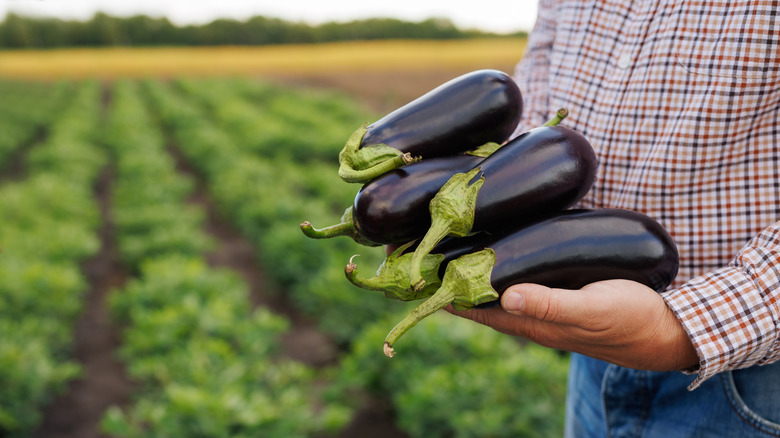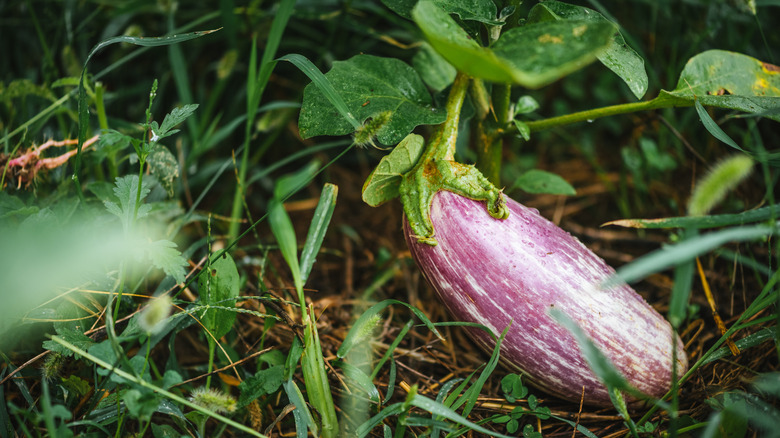How To Harvest Eggplant From The Garden For The Best Flavor
Eggplants are one of those garden vegetables that can feel a little intimidating when it comes to knowing the right time to harvest. Unlike tomatoes, which turn noticeably red, or cucumbers, which practically announce their readiness by size, eggplants grown in containers or garden beds have a more subtle tell. The reward, though, is worth it: When you nail the timing, you're treated to glossy, firm fruits with tender flesh and a rich, almost creamy flavor. Leave them too long, and the taste veers towards bitterness while the texture of the vegetable actually toughens. Harvest too early, and you will miss out on their full potential. Fortunately, there are reliable cues to help you recognize when your eggplant has reached peak ripeness (size, feel, and shine are the major ones) and how to handle it properly for the best results.
When harvesting, forget the typical tug-and-pull method that you might use with other vegetables. Eggplants have thick, woody stems that can resist even the most determined hands, so a clean cut is the right way to go. Use a pair of sharp garden shears or pruners and snip the stem about an inch above the fruit, leaving the little "handle" intact and attached. This will prevent the skin from tearing and makes carrying multiple vegetables easier. If you're growing a variety like Black Beauty, look for a deep, dark purple shine, while lighter or patterned varieties should still have a firm, glossy appearance to them. Keep in mind that eggplants don't continue ripening once harvested so trust your eyes and hands over wishful thinking. A properly harvested eggplant will feel slightly springy when pressed, and it should bounce back without leaving an indentation; a clear sign it's ready for the kitchen.
When is the right time to harvest your eggplants
The perfect time to harvest an eggplant depends on both the variety you planted and your culinary goals, but there are clear indicators that can guide you. As a general rule, most eggplants are ready to pick when they reach their expected size, since waiting for maximum growth can lead to overly seedy, bitter fruits. Shine is another dependable indicator: Ripe eggplants will have a lustrous, glossy skin. When the skin starts looking dull or faded, it isn't a sign your eggplant is dying, but it usually means the fruit has gone past its prime picking time. If you're unsure, perform the thumb test — press gently into the skin of the eggplant. If it springs back, the eggplant is ripe; if the dent stays, it may have over-ripened. Depending on the weather and growing conditions, most eggplants are ready for harvest 65 to 80 days after transplanting, but again, appearance and touch are better guides than the calendar.
Harvesting your eggplants at the right time isn't just about taste, either — it also benefits the plant's productivity. The more frequently you pick eggplants, the more the plant will continue producing. For gardeners who want a steady supply, harvesting smaller fruits more often encourages new blossoms and extends the growing season. And don't overlook the variety-specific traits either: Some slender Asian types are ready when they're just 6 inches long, while larger globe types should feel dense in your hand. By keeping a close eye on skin sheen, firmness, and overall size, you'll develop a sense for the perfect harvest window. Paired with the right eggplant companion plants, your meals will benefit from the eggplant's best flavor and texture.

